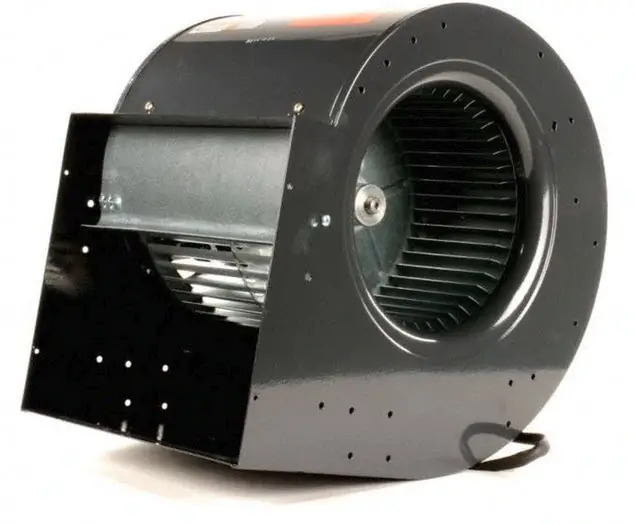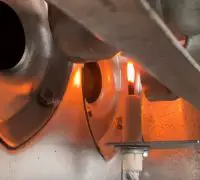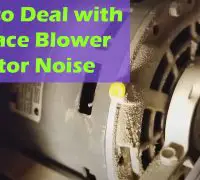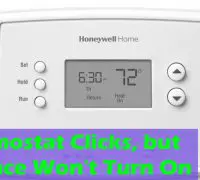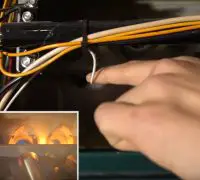Even if furnaces are great, especially the high-efficiency models, they’re sophisticated appliances that run and stop all the time. They have to take a lot of wear, so the risk of problems is never null.
Some issues happen more often than others, and a blower motor humming without starting is a common problem. A tiny and relatively cheap electrical part, the capacitor, may cause the issue. Should the blower motor be the problem, you will need to pay more for repairs. Having said that, we should highlight that it’s most likely the capacitor that is humming and not the blower motor.
Page Table of Contents
How many kinds of capacitors are used?
There are two main categories of capacitors: the start capacitors and the run models. Most furnaces come with just one capacitor, which is commonly known as the run capacitor. Dual run capacitors are installed in the AC condensing units and packaged heat units, as they use two fans simultaneously, like the AC fan and the blower fan.
Replacing the capacitor isn’t complicated, and you don’t always have to call the HVAC technician. It depends a lot on whether you need to remove the capacitor bracket or not. Some models won’t require removing the bracket, so it’s less complicated to replace the capacitor. There are also models where a panel/control board has to be removed.
How to troubleshoot a bad capacitor?
The first step to take is to make sure that the blower hums, but there’s no air going through the grates. Make sure that the thermostat setting is higher than the temp reading and see if there’s air blowing or not.
We’re making sure that you have a problem because some furnaces will typically create a subtle hum every time the power is on. It’s a problem only when the buzz is louder and can be described as a buzzing noise.
Keep in mind that furnace blower motors used a lot of power when running, as they’re cumbersome. The furnace voltage is 110-120, which isn’t enough for them to work. The capacitor will store up to 400+ Volts of energy. The collected energy is released for starting the blower when the moment comes, spreading the furnace heat and containing the cold air for heating.
You can always call the HVAC professional to take a look at the blower. The humming blower that doesn’t rotate when the thermostat requests for heat could signal a faulty run capacitor.
Another way to address the problem is to start the blower manually. Of course, you will need the tools, patience, meticulosity, and some experience to work with furnaces.
Here are the steps to take:
- Get a long screwdriver, paper towel, or wooden dowel. It would help if you didn’t use your fingers for the jo.
- Try to figure out which way the blower should be rotating. Typically, it’s a directional arrow displayed on the blower’s housing.
- Turn the thermostat down, shut off the furnace from the switch on/close to the furnace. The button should be similar to a light switch.
- Attempt to rotate the blower fan in the right direction. If the movement is effortless, it means that the motor isn’t seized up. Once again, it’s a sign that the capacitor is causing the noise and the problem.
- Make sure that the furnace switch is still off and take a look at the thermostat. Turn on the fan to On mode and see if the hum hears again. Is the fan always not rotating?
- Now it’s time to use a turn on the furnace back again. Is the humming sound still present? Does the fan rotate?
- Use your fingers or a dowel and try to spin the blower in the proper direction. Do a fast nudge or flick to check it. It’s how you give the extra energy to overcome the inertia.
- Is the blower firing up or not? If the answer is yes, it means that the capacitor is causing the problem. If the answer is no, the blower motor is probably burned out. You should call the HVAC technician for repairs.
Check the capacitor-just to be sure it’s causing the problem!
Remember that the run capacitor collects energy so that it can hold even more than 400 volts. You shouldn’t address the capacitor if you feel it’s too much. After all, you’re not an HVAC technician.
For those of you who have skills and courage, here are the steps to follow for checking the capacitor on the furnace:
- Begin with discharging the capacitor. Use an insulated screwdriver (synthetic/rubber/plastic handle with no cracks in the handle). Place the screwdriver horizontally along with the two terminals. Needless to say, you have to turn off the furnace, and the capacitor should be in its place.
- Take the capacitor from its place, removing the screws that hold the bracket. Pull off the connectors after slipping out the capacitor (“shorting the capacitor”).
- The capacitor rating should be easy to read; it’s a microfarad number, MFD. The printed label should read “+/-10%”. Anything from 9 to 11 on the multimeter turned to Capacitance is a good read.
- Turn the multimeter dial to Capacitance for testing the run capacitor (look for the next symbol)
Place one of the meters leads on every terminal of the capacitor. Please take a look at the meter while holding them.
- OK- When the meter reading displays that the capacitor is OK, you will still have to call the professional. He will run the same test on the blower motor and replace it if it is damaged.
- Wearing out- When the number rises but doesn’t reach the microfarad rating (+/-10%), the capacitor is already wearing, so replacement is necessary.
- Dead- The capacitor is entirely dead if nothing is read after 30-60 seconds.
How should you buy a capacitor? Where do you buy it from?
You will have to check the voltage rating and the MFD (microfarad) rating for selecting the capacitor. It isn’t easy to find the capacitor in local shops, and hardware and home improvement stores don’t supply it typically. You will have a better chance when shopping online.
Also, you can call and try to find local HVAC parts dealers that supply capacitors to homeowners.
Is it expensive?
You will pay anything from $5 to $20 for the capacitor. Even if you may get away this time with not buying a replacement, it can be a matter of time until you need to replace it. If you’re wise, you should buy the capacitor and an extra igniter, too, to be sure.
If you’re calling a professional for replacing the capacitor, you will pay anything from $80 to $200. The capacitor is relatively cheap, and replacing shouldn’t take more than 20 minutes. Regardless of these aspects, the minimum service fee for an HVAC technician is $75.
